RF sensors providing functionalities such as detection, tracking and identification of targets and RF signals are based on a multifaceted set of performance technology enablers hardly imagined a few years ago. In this article, the challenges that the European RF Sensor Research and Technology (R&T) community is facing are discussed with a systems-level perspective. The aim is to produce RF sensor systems that comply with current performance demands at an adequate cost, taking into account evolving scenarios and fluctuating requirements.
he way these challenges can be faced optimally in Europe is through the implementation of collaboration programs in defence R&T like those under the framework of the European Defence Agency (EDA). Research trends related to these kinds of sensors and some characteristics of related program schemes are analyzed. The interest in standard architectures based on building blocks (BB) developed through system engineering approaches is highlighted in this article. The involvement of scientists and engineers must adequately be taken into account in order to optimize results and processes within the European supply chain.
FROM HERTZ AND TESLA TO COGNITIVE, ADAPTIVE AND SELF-LEARNING RF SENSORS
Many years ago, Heinrich Rudolf Hertz (1857–1894) failed to give value to his own experiments and discoveries, stating that they were of no use even when he had proven the existence of Electromagnetic Fields (EMF) previously theorized by James Clerk Maxwell. It is evident that he could not imagine the huge number of possibilities he had created for the future and how significant his experiments were. Unfortunately, Hertz died very young, but other geniuses like Nicola Tesla (1856–1943) were able to capitalize on several of the possibilities in very innovative ways.
The world has evolved much from the times of Hertz and Tesla. The romantic figure of the wise researcher stimulating vocations of engineers and physicists is progressively disappearing. Interest in technical careers seems to be declining in favor of more humanistic and chrematistic pursuits, even if the current delight provided by the social media comes from defence research.1 The number of engineers working on defence technologies in Europe is steadily decreasing and the demographic is aging. Their skills and knowledge will disappear if new R&T collaborative projects with clear procurement paths are not established soon.
Understanding the importance of the RF sensors market is critical. In 2012 the revenue corresponding to global defence exports for radar technology exceeded $7 billion.2 An analysis by Visiongain market research indicates that the military radar systems market was valued $8.57 billion in 2013 and an estimation of the global Electronic Warfare (EW) market is $12.15 billion for 2014, with the expectation of reaching $15.59 billion by 2020.3
From the equipment perspective, the explosion in performance provided by devices like ubiquitous FPGAs, GPUs “spawned by the $80 billion video gaming industry4” and ASICs makes it possible to incorporate increasingly closer to human behaviors with progressively decreasing size, weight, power and cost (SWaP-C). The ability to adapt to the environment and self-learn will provide a strong tool to the systems of the next generation coping with the challenges imposed by the threat evolution.5
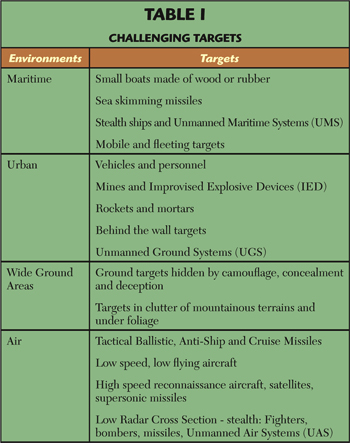
THE DEFENCE ENVIRONMENT AND ITS CHALLENGES IN 2014
The concept of defence has certainly evolved, but military capabilities must adapt to current scenarios, many times mixing with civil or more precisely, security capabilities. For the last 50 years military concepts have been based on conventional warfare, relying on deterrence as the principal way of avoiding wars. Nowadays the focus has shifted toward asymmetric/unconventional warfare and cyber attacks, seriously affecting other domains and redefining electronic warfare (EW) approaches. This evolving scenario has led to the need for flexibility and readiness. Advances in technology allow for very complex systems that can flexibly and adaptively respond to new threats and deployment scenarios. This imposes challenges in the validation and verification of new assets as a system’s performance may be downgraded or lose generality when forced to adapt to a new environment.
The EDA RF Sensors community is seeking systems that will provide situational awareness through more persistent surveillance and is focusing its efforts on improving sensitivity to detect increasingly challenging targets in complex environments with high levels of RF interference, spectrum regulation constraints and dense clutter. Some examples are listed in Table 1.
Beyond detection, targets must also be tracked and identified to avoid fratricide in case of engagement. This normally requires complex algorithms to perform multi-tracking, including sensor fusion and the population of target databases scrutinized in near real-time to provide the correct identification of the target type and its potential for hostility.
There is an increasing need for advanced technology and information superiority to support future military operations in a fiscal atmosphere of reduced R&D expenditure. For the 26 EDA pMS in 2012 this reduction was 36 percent, assuming a total amount of €4.8 billion which is half of the amount invested in 2006.6 This comes at a time when the world is replete with social and regional convulsions, state failures and international tensions. This underscores the need to continue investing in military assets. As an example, Russia plans to invest $561 billion in modernizing its army and fleet plus $84 billion in modernizing production defence plants.7
RF SENSORS TAXONOMY
The complexity of an RF sensor system can be visualized through the non-extensive taxonomy summarized in Table 2. The higher the system performance required, the more complex the configuration, waveforms and/or functionalities, and likely higher costs. A challenging exercise in the current economic situation is to provide extraordinary performance that cannot be afforded and may even not be needed in order to be prepared for unpredictable scenarios.
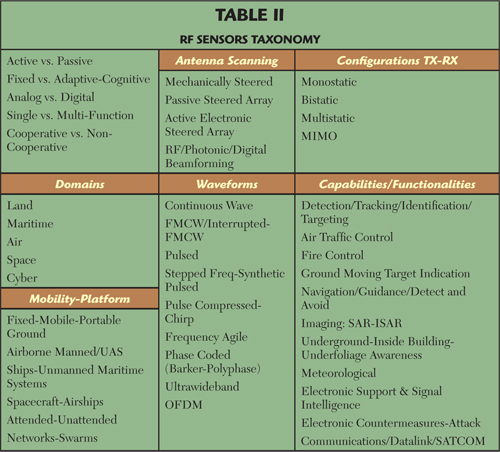
Increasing system complexity is required for several reasons, such as:
- The need for flexibility/plasticity due to changing environments and scenarios.
- The need for decreased SWaP-C attained through the development of modular and scalable multi-function systems based on flexible building blocks.
- The need for coexistence and resistance to interference with other systems, which has been exacerbated by the scarcity of RF spectrum, driving new concepts of adaptability, self-learning and anticipation.
These extremely complex systems require controlled methodologies to cover the whole life cycle in order to ensure proper management, cost limitation and control of risks. Systems engineering frameworks are required to provide the path for structured funding approaches, once proper system architectures are established.
This opens the door to both cooperation and competition of different kinds, with a specific approach to the management of intellectual property rights (IPR), which is often the cause for industry reluctance to participate in international research programs. It is essential for governments to continue their research efforts to take advantage of funding already invested. The establishment of hybrid standards (security-defence-commercial) defining these architectures can be the solution for dual developments in smart and fruitful ways.
To deal with systems complexities, engineers must have a multidisciplinary profile and master systems engineering approaches. The critical defence professionals’ skills are currently a matter of analysis at the agency.
SPECTRUM MANAGEMENT
The dispute for the frequency spectrum between military and commercial applications is a major issue. Global allocations of radio spectrum are agreed upon at the International Telecommunication Union (ITU) World Radiocommunication Conferences (WRC) for each ITU Region and incorporated in the Radio Regulations. The outcomes of WRCs have a treaty status.8
The right to use a fraction of the spectrum constrains sensor performance and implies the need to carefully select the frequency band and mitigation measures implemented to comply with the regulations. In that sense, it has to be determined long in advance that a system designed and manufactured for a specific application will have the necessary technical and legal support to meet its performance expectations, including the necessary spectrum protection.
The increase by an order of magnitude in commercial connected devices, estimated from 5 billion in 2010 to 50 billion in 2020,9 portends a strong spectrum demand which may impact its availability for military operations. This is already being discussed, as new spectrum allocations are on the open agenda items for the next WRC in 2015.10 Two examples are the mobile service for International Mobile Telecommunications (IMT) and the Wireless Avionics Intra-Communications (WAIC). Future band allocations and out-of-band mask requirements for communications systems could lead to degradation in the performance of military assets, mainly radars, working in these bands.
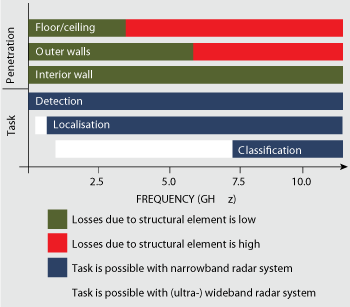
Figure 1 Choice of frequency for TTW radar systems from the RIBA study.
The lower frequency bands traditionally used for communications (HF, VHF and UHF) have gained renewed interest from radar systems designers. They provide over-the-horizon (OTH) capability, anti-stealth characteristics, higher penetration depth through foliage, ground and walls, and they look quite promising for perimeter detection and camp protection.
The ability of OTH to detect and track targets at distances between 1,000 and 4,000 km makes it very attractive for maritime surveillance and tactical ballistic missile (TBM) detection, even though the issue of low resolution must be solved and improved through adaptive and self-learning capabilities. The size of antennas is also raising environmental impact concerns. Radars working at frequencies below a GHz also have the advantage in that low observability measures are normally developed to reduce detectability at higher frequencies.
The spectrum needs of other applications that may be operational in the coming years must be anticipated. Non cooperative target recognition (NCTR) capability requires wide bandwidths, usually more than 250 MHz that should be made available in X-Band for airborne and L- or S-Bands for ground radars. Ultrawideband (UWB) systems may need up to 3 GHz of bandwidth, enabling different dual (civilian-military) applications like through-the-wall (TTW) radar. Figure 1, from the OB study RIBA,11 shows the possibilities for frequency selection in TTW radar. Final selection must be done based on current regulations, leaving little room for development due to frequency availability.
The project FARADAYS (2010-2013) “Frequency allocation for radars in the coming years” has analyzed spectrum needs for future military radars providing several considerations and recommendations to ensure a proper functioning of future generation of RF sensor systems (see Figure 2).
UAVs AND AESA ANTENNAS
Even with strong societal concerns about the use of remotely piloted aircraft (otherwise called drones or UAVs), these systems will be regulated and safety issues solved as we cannot neglect their benefits. The development of their payloads is an essential topic. EDA has contracted a study12 that analyzes the accessible RPAS payloads market. Its conservative forecast value is €17.5 billion and the higher growth estimate is €23.6 billion for 2014-2035. Other estimates13 considering a wider range of UAV payloads including EO/IR, SAR, SIGINT, EW and C4I Systems, and CBRN Sensors assess it at $3 billion per year currently, increasing to $5.6 billion annually by 2020.
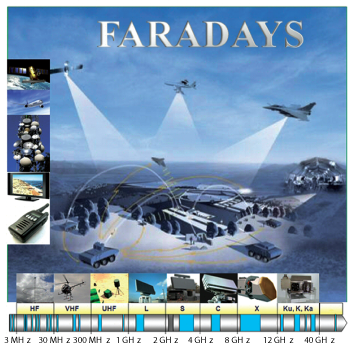
Figure 2 FARADAYS project.
Multifunction RF sensors integrate radar, communications, EW and/or detect and avoid. They will be part of the next generation of payloads and are optimally approached when they make use of AESA antennas as multifunction shared apertures operating in different frequency bands with different instantaneous bandwidths. This increases the capability of small platforms with low SWaP and reduces the number of apertures required. A proper resource manager module to organize and share resources is mandatory.
AESA antennas can be designed to be modular and scalable. This means that the BBs for the antenna can be used across many platforms and for different sized apertures which lowers production costs through economies of scale. It is unavoidable to mention the role of GaN as a breakthrough for AESA and the possibilities that it opens in this field.
The next step is to develop conformal AESA antennas, which is being analyzed by the EDA OB study UCAR.14 AESA antennas have the potential to achieve low RCS. This feature is important for military UAVs designed for low observability (LO); and they do not compromise aerodynamics improving the capability of maneuvering, reducing fuel consumption and increasing endurance.
Another benefit of the AESA is graceful degradation, since only a common subsystem power supply or beam steering control failure can generate a general system failure. With proper monitoring and built in test (BIT) systems, the AESA can tolerate failure in some modules by using the working ones to provide acceptable results through adaptive beamforming.
Many more aspects of AESA design may be leveraged to address advanced applications including:
- Architectures
- Wideband arrays
- Low profile and bandwidth enhancement techniques like metamaterials or non-foster matching
- Conformal array pattern synthesis techniques
- RF-on-fiber
- Thermal management
- Manufacturing and integration
- True Time Delays (TTD) for wideband designs
- Cognitive methodologies and architectures to reduce the effect of interference through frequency nulling and other mitigation techniques.
NEW APPROACHES IN PROCESSING: COMPRESSIVE SENSING (CS)
The new paradigm for acquisition and sampling known as compressive sensing (CS) is attracting interest by promising enhanced system performance, while decreasing speed requirements for ADCs and DACs and saving on other hardware resources. The study “Radar Implementation of CS (RICS)”15 is funded by the agency to assess its application in military RF sensors. One of the main objectives is establishing a framework to build future initiatives and serve as a guide and orientation to CS military applications.
CS has a different structure than classical filtering approaches and exceeds their computational complexity. It is appropriate only when there is a potential improvement like obtaining higher resolution or reducing the number of measurement positions, antennas or radiating elements, sampling frequencies and grating lobes. The central point for the applicability of CS is the sparsity of a representation of the considered scenery, so it is fundamental to find a domain where this sparsity appears. It would be interesting to modify test devices to obtain measurements fitted to the architecture of CS reconstruction based on non-uniform sampling.
The assessment of CS results is being done by estimating the quality of reconstruction through Monte Carlo analyses, although more realistic error bounds are under consideration. CS approaches are usually much slower than classical filtering methods, so a real-time radar application is still challenging. Promising applications include active and passive inverse synthetic aperture radar (ISAR) imaging, direction of arrival (DOA) estimation, sparse array design procedures and receivers.
The CS-based receiver may open the way for new capabilities such as radar systems operating over large instantaneous bandwidths or even simultaneously on different narrow band carriers, instead of the time division methods normally used by surveillance and multifunctional radars. This would be particularly interesting for electronic protective measures (EPM).
EUROPEAN RF SENSORS SYSTEMS R&T COLLABORATION
EDA hosts a group of experts covering the subject of RF Sensors Systems and Signal Processing that meets in the Capability Technological Area (CapTech) called RF Sensors Technologies (RFST) formerly known as IAP2. It belongs to the Unit Innovative Research (INR) from the Directorate European Synergies and Innovation (ESI).
The projects under the CapTech may be:
- Funded through the operational budget (OB) of the agency where specific subjects are analyzed, state of the art is discussed and roadmaps for research proposed. Examples are the previously mentioned RICS and UCAR.
- Ad Hoc Category B projects16 common collaborative work funded by contributing members, normally 3 to 5, with values ranging an average of €2 to 4 million in a bottom-up approach.
- Ad Hoc Cat A activities17 involving a larger number of contributing members through a top-down approach. Funding is provided on a voluntary basis, typically over €10 million per project.
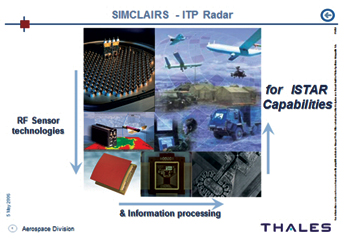
Figure 3 SIMCLAIRS project.
Multifunction: The projects STRATA and SIMPLE paved the way for the Scalable Multifunction RF Systems (SMRF) Program to build these sensors in a modular and scalable way. Under that umbrella, the AMBASSADOR project (2012-2013) was considering the modern architectural frameworks that must be used when defining complex systems as SMRF. A value assessment of model-based approach to product development predicted reductions in costs and time by about a third and the decrease of associated risks in development cost and schedule by about two thirds.
SIMCLAIRS (2009-2013) was an Innovation and Technology Partnership (ITP) aimed to de-risk and mature key enabling technology areas to achieve TRL 4 and to allow breakthroughs in the overall capabilities of compact multifunction RF sensors, identifying and quantifying the military benefits of this class of technologies (see Figure 3).
This model of cooperation was very successful since there were two calls for competed projects allowing research suppliers from industry, SMEs and academia to contribute in the various technical domains. Subcontracts were awarded on the basis of merit with the most “competitive” bids securing funding.
A future project called SIRONA under a similar scheme is in preparation and will deal with the maturation of enabling hardware technologies for UAS payloads including both RF and electro-optical sensors.
NCTR: The use of imaging techniques like high resolution range profiles (HRRP) and inverse synthetic aperture radar (ISAR) is demonstrating the ability to address previous limitations and perform effectively in automatic target recognition (ATR) systems. In that sense, the ongoing project SPERI (2013-2015) includes research on superresolution for ATR on real images, CS and 2D space variant apodization. ACACIA is a 3-year project starting in 2014, that will focus on emerging waveforms, signal processing and feature-based classification techniques. MAPIS as follow up to JIP-ICET APIS will study, define and analyze a new system concept for implementing and demonstrating ISAR imaging capability in multistatic array passive radar to enable the capability of passive NCTR.
Urban Sensors: TELLUS (2008-2012) explored technologies for solutions to difficult environments with smoke and dust, darkness, bad weather and concealed conditions, particularly in urban warfare scenarios looking for low cost, light weight and low power consumption for radar and ESM systems. TELLUS II is under preparation.
Biological: RFBIO is a 5-year project studying the biological effects of the military EM signals used by defence systems like radar or EW that are not covered by civil domain studies. A mechanistic approach will be established to try to understand the interactions between RF signals and biological systems. The projects already finished are worth more than €60 million and the estimates of the coming ones are around €30 million.
CONCLUSION
The EDA RF Sensors Technologies (RFST) community is dealing with the design and development of systems capable of performing challenging functions like detection, tracking and identification of difficult targets and RF signals surrounded by strong and changing clutter, and evolving scenarios congested with jamming, coexistence of a broad variety of sensors and spectrum limitations.
This implies the need for flexibility and adaptability bringing more complexity in terms of signal processing, demanding hardware, and test and validation requirements. The uncertainty in the number and experience of future engineers may be added as an issue of strong concern in the European supply chain and the need of multidisciplinary profiles and skills is highlighted.
Solutions should come from collaborative programs based on system engineering disciplines and their corresponding frameworks. Through model based system engineering, the design and development of RF sensors systems allows for continuous monitoring and management leading to decreased life cycle costs and more sustainable approaches. It also enables the development of modular, scalable and multifunction systems which are essential considering the constraints in size, weight, power and cost.
To enable this approach, standard architectures must be produced to foster collaboration through European programs managed through the instantiation of individual building blocks (BB) defined through standardized interfaces. With a tailored IPR scheme, the sensitivity of the BBs will be lower for the entire system, allowing competitive programs to demonstrate the concept on complete systems through integration of the BBs. We have provided an overview of the main EDA RFST (IAP2) CapTech Ad Hoc Cat B collaborative projects dealing with some of the main challenges that the RF sensors community is facing, describing specific points in terms of capability gaps and technical issues at system level. The key message is that international collaboration, like the one under the EDA framework, is a cost-effective way to deal with research topics covering capability gaps in times of limited defence budgets.
References
- B.M. Leiner, V.G. Cerf, D.D. Clark, R.E. Kahn, L. Kleinrock, D.C. Lynch, J. Postel, L.G. Roberts and S. Wolff, “Brief History of the Internet,” Internet Society, October 2012, www.internetsociety.org/internet/what-internet/history-internet/brief-history-internet, accessed 3 May 2014.
- “Briefing: Tipping the Balance,” Jane’s Defence Weekly, 27 June 2013.
- “Electronic Warfare Market (Electronic Support, Electronic Attack and Electronic Protection) - Global Forecast and Analysis 2014 – 2020,” Electronic Warfare Market Forecast Analysis: MarketsandMarkets, December 2013, www.marketsandmarkets.com/Market-Reports/electronic-warfare-market-1301.html?gclid=CMzo3Jmj7b8CFYMF7Aodkk8Aiw, accessed 2 May 2014.
- C. Adams, “Game Changer in Signal Processing,” Military Embedded Systems, October 2012, http://digital.mil-embedded.com/oct2012/Default/0/0#&pageSet=5&contentItem=0, accessed 3 May 2014.
- “Adaptive, Self-learning and Anticipative Radar (ASAR),” Executive Summary, EDA Contract 10.R&T.OP.02.
- “Defence Data 2012,” EDA News, December 2013, www.eda.europa.eu/info-hub/news/2013/12/10/defence-data-2012, accessed 3 May 2014.
- “Russia Should Be Ready for Non-contact War,” Spacewar.com, www.spacedaily.com/reports/Russia_should_be_ready_for_non_contact_war_999.html, accessed 3 May 2014.
- “Final RSPG Opinion request by the European Commission on Best Practices Regarding the Use of Spectrum by Some Public Sectors.” EUROPEAN COMISSION DG INFSO/B4/RSPG Secretariat, February 2009, http://rspg-spectrum.eu/_documents/documents/opinions/rspg09_258_rspgopinion_pus_final.pdf, accessed 3 May 2014.
- A. Osseiran, V. Braun, T. Hidekazu, P. Marsch, H. Schotten, H. Tullberg, M.A. Uusitalo and M. Schellman, “The Foundation of the Mobile and Wireless Communications System for 2020 and Beyond Challenges, Enablers and Technology Solutions,” VTC Spring 2013, June 2013, https://www.metis2020.com/documents/publications/, accessed 3 May 2014.
- “World Radiocommunication Conference 2015 (WRC-15) Agenda and Relevant Resolutions,” International Telecommunication Union, www.itu.int/en/ITU-R/seminars/rrs/Documents/Intro/WRC-15-Booklet.pdf, accessed 3 May 2014.
- “Radar Technology for Inside Building Awareness (RIBA),” Executive Summary, EDA Contract11.R&T.OP.131.
- “Non EU Dependencies: Investing in Key Unmanned System Technologies and Capabilities,” Executive Summary. EDA contract12.I&M.OP.337.
- “UAV Payloads 2014,” Defence IQ, June 2014.
- “UAS Conformal AESA Antennas Roadmap (UCAR), D1-2 UCAR WP2 Draft Report State-of-the-Art Review,” EDA contract 13.R&T.OP.639.
- “Radar Implementation of Compressive Sensing (RICS),” Executive Summary, EDA contract 12.R&T.OP.270.
- “Randt User Guide. Category B Projects,” European Defence Agency, www.eda.europa.eu/randtuserguide/home/r-t-instruments/category-b-projects, accessed 04 May 2014.
- “Randt User Guide, Category A Projects,” European Defence Agency, www.eda.europa.eu/randtuserguide/home/r-t-instruments/category-a-programmes, accessed 04 May 2014.
